Javelina Formation
The Javelina Formation is a geological formation in Texas. Dating has shown that the strata date to the Maastrichtian stage of the Late Cretaceous, approximately 70 to 66.5 million years old.[1] The middle part of the formation has been dated to about 69 million years ago plus or minus 1 Ma and the top situated near the Cretaceous–Paleogene boundary (in the overlying Black Peaks Formation[1]), dated to 66 Ma ago.[2] Dinosaur remains are among the fossils that have been recovered from the formation.[3]
| Javelina Formation Stratigraphic range: Maastrichtian, 70–66.5 Ma | |
|---|---|
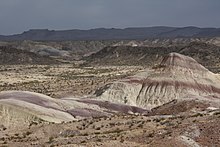 Distinctive mauve and red beds of the Javelina Formation outcropping in Big Bend National Park, Texas | |
| Type | Geological formation |
| Unit of | Tornillo Group |
| Underlies | Black Peaks Formation |
| Overlies | Aguja Formation |
| Lithology | |
| Primary | Sandstone |
| Other | Claystone, mudstone, siltstone, conglomerate |
| Location | |
| Coordinates | 29.3°N 103.4°W |
| Approximate paleocoordinates | 36.0°N 82.8°W |
| Region | |
| Country | |
| Type section | |
| Named for | Javelina |
 Javelina Formation (the United States)  Javelina Formation (Texas) | |
Age
The typical age range of the Javelina Formation has been difficult to determine.[4] Only one geological site in the Javelina Formation has thus far yielded the correct rock types for radiometric dating. The outcrop, situated in the middle strata of the formation about 90 meters below the K-Pg boundary and within the local range of Alamosaurus fossils and below two sites that have yielded Quetzalcoatlus fossils, was dated to 69.0 plus or minus 0.9 million years old in 2010.[2]
Fossil content
Vertebrate paleofauna
| Vertebrates of the Javelina Formation | ||||||
|---|---|---|---|---|---|---|
| Genus | Species | Location | Stratigraphic position | Material | Notes | Images |
| Alamosaurus | A. sanjuanensis | A titanosaurian sauropod, also from the Ojo Alamo Formation | 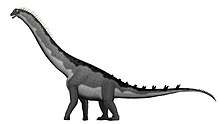 | |||
| Bravoceratops | B. polyphemus | A chasmosaurine ceratopsid |  | |||
| Dasyatis[5] | Unknown | A ray | ||||
| Gryposaurus?[6] | G.? alsatei[6] | A saurolophine handrosaurid | 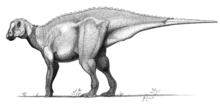 | |||
| Kritosaurus[6] | K. sp.[6] | A saurolophine handrosaurid | 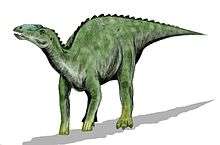 | |||
| Quetzalcoatlus | Q. northropi | An azhdarchid pterosaur | 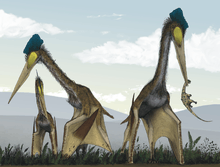 | |||
| Rhombodus[5] | Unknown | A ray | 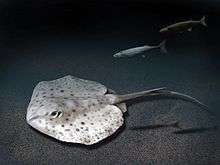 | |||
| Saurornitholestes[7] | S. cf. langstoni | A dromaeosaurid | ||||
| Saurolophinae[6] | Indeterminate[6] | A saurolophine handrosaurid | ||||
| Torosaurus[8] | T. utahensis[8] | A chasmosaurine ceratopsid |  | |||
| Troodon | T. sp. | A troodontid | .jpg) | |||
| Tyrannosaurus | T. sp. | A tyrannosaurid, originally identified from the Hell Creek Formation. Also found in the Denver, Ferris, Frenchman, Lance, Livingston, McRae, North Horn, Scollard, and Willow Creek Formations. |  | |||
| Trionychidae | Indeterminate | Indeterminate turtle remains | ||||
Flora
| Flora of the Javelina Formation | ||||||
|---|---|---|---|---|---|---|
| Genus | Species | Location | Stratigraphic position | Material | Notes | Images |
| Javelinoxylon[9] | J. multiporosum[10] | A dicotyledonous tree | ||||
See also
- List of dinosaur-bearing rock formations
- List of pterosaur-bearing rock formations
- List of fossiliferous stratigraphic units in Texas
- Paleontology in Texas
- Cretaceous Texas
- Corsicana Marl
- El Picacho Formation
- Escondido Formation
- Kemp Clay
- Nacatoch Sand
- Neylandville Marl
References
- Woodward, H. N. (2005). Bone histology of the sauropod dinosaur Alamosaurus sanjuanensis from the Javelina Formation, Big Bend National Park, Texas.
- Lehman, T.M.; McDowell, F.; Connelly, J. (2006). "First isotopic (U-Pb) age for the Late Cretaceous Alamosaurus vertebrate fauna of West Texas, and its significance as a link between two faunal provinces". Journal of Vertebrate Paleontology. 26: 922–928. doi:10.1671/0272-4634(2006)26[922:fiuaft]2.0.co;2.
- Weishampel, David B; et al. (2004). "Dinosaur distribution (Late Cretaceous, North America)." In: Weishampel, David B.; Dodson, Peter; and Osmólska, Halszka (eds.): The Dinosauria, 2nd, Berkeley: University of California Press. Pp. 574-588. ISBN 0-520-24209-2.
- Sullivan, R.M.; Lucas, S.G. (2006). "The Kirtlandian land-vertebrate "age" – faunal composition, temporal position and biostratigraphic correlation in the nonmarine Upper Cretaceous of western North America" (PDF). New Mexico Museum of Natural History and Science, Bulletin. 35: 7–29.
- Hunt, ReBecca K.; Santucci, Vincent L.; Kenworthy, Jason (2006). "A preliminary inventory of fossil fish from National Park Service units." in S.G. Lucas, J.A. Spielmann, P.M. Hester, J.P. Kenworthy, and V.L. Santucci (ed.s), Fossils from Federal Lands". New Mexico Museum of Natural History and Science Bulletin. 34: 63–69.
- Lehman, Thomas M.; Wick, Steven L.; Wagner, Jonathan R. (2016). "Hadrosaurian dinosaurs from the Maastrichtian Javelina Formation, Big Bend National Park, Texas". Journal of Paleontology: 1–24. doi:10.1017/jpa.2016.48.
- Sankey, J. T.; Standhardt, B. R.; Schiebout, J. A. (2005). "Theropod teeth from the Upper Cretaceous (Campanian-Maastrichtian), Big Bed National Park, Texas. In K. Carpenter (ed.), The Carnivorous Dinosaurs". Indiana University Press, Bloomington: 127–152. Cite journal requires
|journal=(help) - Hunt, ReBecca K.; Lehman, Thomas M. (2008). "Attributes of the ceratopsian dinosaur Torosaurus, and new material from the Javelina Formation (Maastrichtian) of Texas". Journal of Paleontology. 82 (6): 1127–1138. doi:10.1666/06-107.1.
- Jacobs, L. 1995. Lone Star Dinosaurs. Texas A&M University Press. p.102
- Wheeler, E. A.; Lehman, T. M.; Gasson, P. E. (1994). "Javelinoxylon, an Upper Cretaceous dicotyledonous tree from Big Bend National Park, Texas, with presumed Malvalean affinities". American Journal of Botany. 81: 703–710.
Further reading
- S. L. Wick and T. M. Lehman. 2013. A new ceratopsian dinosaur from the Javelina Formation (Maastrichtian) of West Texas and implications for chasmosaurine phylogeny. Naturwissenschaften
- T. M. Lehman and A. B. Coulson. 2002. A juvenile specimen of the sauropod dinosaur Alamosaurus sanjuanensis from the Upper Cretaceous of Big Bend National Park, Texas. Journal of Paleontology 76(1):156-172
- A. R. Fiorillo. 1998. Preliminary report on a new sauropod locality in the Javelina Formation (Late Cretaceous), Big Bend National Park, Texas. In V. L. Santucci & L. McClelland (eds.), National Park Service Geologic Resources Division Technical Report NPS/NRGRD/GRDTR-98/01. National Park Service Paleontological Research Volume 3:29-31
- A. W. A. Kellner and W. Langston. 1996. Cranial remains of Quetzalcoatlus (Pterosauria, Azhdarchidae) from Late Cretaceous sediments of Big Bend National Park, Texas. Journal of Vertebrate Paleontology 16(2):222-231
- D. A. Lawson. 1976. Tyrannosaurus and Torosaurus, Maestrichtian dinosaurs from Trans-Pecos, Texas. Journal of Paleontology 50(1):158-164
- D. A. Lawson. 1975. Pterosaur from the latest Cretaceous of West Texas: discovery of the largest flying creature. Science 187:947-948